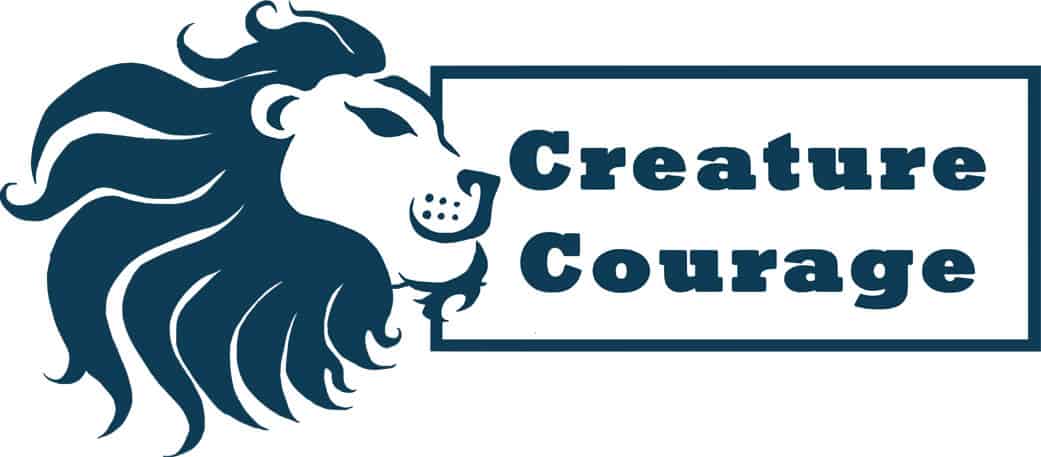No Need to Fear the Mud Dauber Wasp
Of all the wasps you might encounter, mud daubers are among the least likely to sting – they’re also not as dirty as they might sound! They’re non-aggressive and generally ignore humans unless directly handled. Their focus is on nest building and providing for their offspring, they do not have large colonies to defend like their yellow jacket and hornet counterparts.
The fear of wasps is known as Spheksophobia, and many people have a fear or phobia about wasps. Indeed, Spheksophobia affects an estimated 5% of the UK population. However, this little wasp is really the least scary of them all, and in this article, you’ll find out more about these amazing little critters as well as why you shouldn’t fear them, but how to overcome that fear of wasps, too.
Find Out More About Overcoming Your Fear of Wasps
Why People Develop a Fear of Mud Dauber Wasps
Phobias often develop in childhood. A sting from a different wasp species, or witnessing someone else’s distress, can embed deep-rooted anxiety. Cultural portrayals of wasps as aggressive or dangerous also contribute, and these learned associations can persist into adulthood, creating lasting emotional responses even when there is no real danger.
Although many people dislike wasps, a true phobia goes beyond mild discomfort. It can trigger panic attacks, nausea, and avoidance behaviours. Interestingly, most people don’t distinguish between aggressive wasps and solitary species like mud daubers, which rarely sting humans.
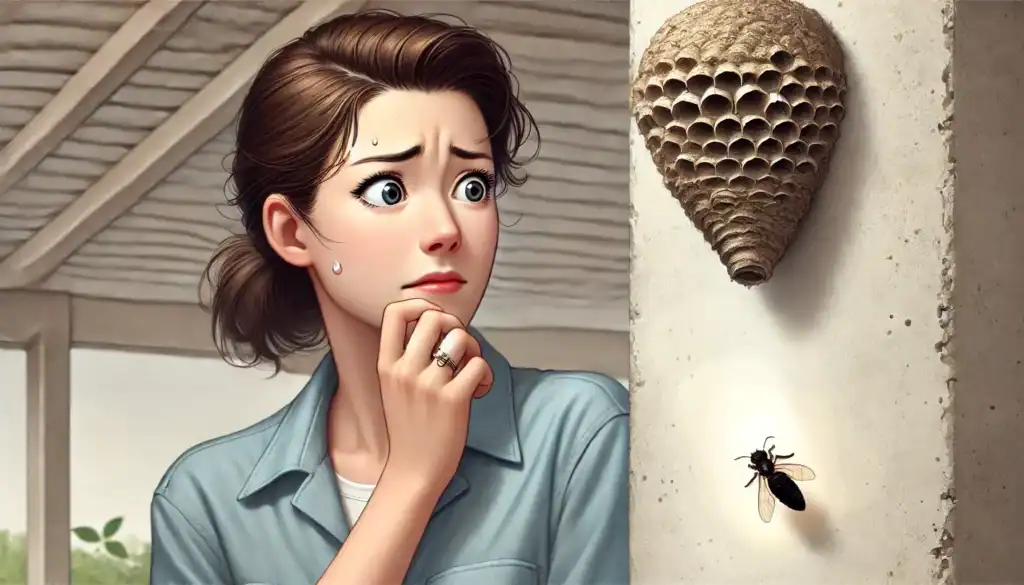
Myth-Busting: Mud Dauber Wasps Aren’t Out to Get You
Contrary to popular belief about wasps, the Mud Dauber species is solitary and non-aggressive. This means they do not live in big groups or build huge hives, which means that they don’t need to defend their nests or form swarms. Mud Daubers are highly unlikely to sting unless handled or provoked – and why would you want to even contemplate handling a wasp! As you can see, you’d have to put in a lot of effort to get one of these little guys to sting you. Most importantly, in all of this, is that their venom isn’t even harmful to humans, unless the person has a particularly severe allergy. Understanding this really can help shift your fear around Mud Daubers.
Further, they are only about ½ to 1 inch-long (12-25 mm). This small size can make them seem less scary still. Moreover, they are actually very beautiful in their own way, honestly! Though, Mud daubers are usually black, some have pale markings or an iridescent blue metallic lustre.
How Mud Dauber Wasps Help Humans and Nature
Mud dauber wasps play a vital role in supporting biodiversity and ecological balance. While they are best known for preying on spiders, they also consume a variety of small arthropods, including flies and caterpillars. This helps regulate insect populations in a natural, non-invasive way. This selective hunting, particularly of species that may overpopulate an area, maintains the health of local ecosystems.
In addition to their dietary contributions, their intricate mud nests offer ecological benefits. These nests improve microhabitats and contribute to soil aeration when they weather down. Furthermore, Mud Daubers contribute to pollination as they feed on nectar, playing a subtle but valuable part in plant reproduction.
Far from being a threat, these solitary wasps are quiet allies in maintaining a balanced environment. Their presence supports both urban and rural ecosystems in ways many people don’t even realise.
Fascinating Facts About Mud Dauber Wasps
- Life Cycle: Female Mud Daubers construct intricate nests from mud, creating tube-like cells for their young. Each cell is stocked with paralysed spiders or other invertebrates that serve as food for the developing larva. The larva slowly consumes the bug or insect before pupating and eventually emerging as an adult. This life cycle reveals not only their survival instincts but also the delicate balance they maintain within the food chain.
- Unique Architecture: Mud Dauber nests are natural engineering marvels. The organ pipe-like structure is made with incredible precision using nothing but mud and saliva. These nests are biodegradable and do not damage property, unlike many insect nests. They demonstrate these creature’s great ingenuity and resourcefulness.
- Gentle and Solitary: Unlike social wasps, Mud Daubers are a solitary species and do not swarm. They quietly go about their lives and are uninterested in human activity around them. This calm nature is a reminder that not all wasps pose a threat.
- Global Presence, Local Benefits: Mud daubers exist on every continent except Antarctica, yet they seamlessly integrate into local ecosystems. In the UK, they’re more common in the warmer months and can often be spotted around quiet garden sheds or eaves, where they do more good than harm.
- Non-Destructive Tenants: Unlike termites or wood-boring insects, Mud Daubers do not cause structural damage. Their nests are temporary and can easily be removed if needed. This low-impact presence makes them among the most benign of insect cohabitants.
- Pollinator Allies: While they are not major pollinators, mud daubers do contribute to pollination as they visit flowers for nectar. Though minor, this role still supports the broader ecosystem in a small but meaningful way.
By understanding these traits, we can begin to appreciate mud dauber wasps for the peaceful and beneficial creatures they are. Building this kind of compassion can help turn our fear into admiration.
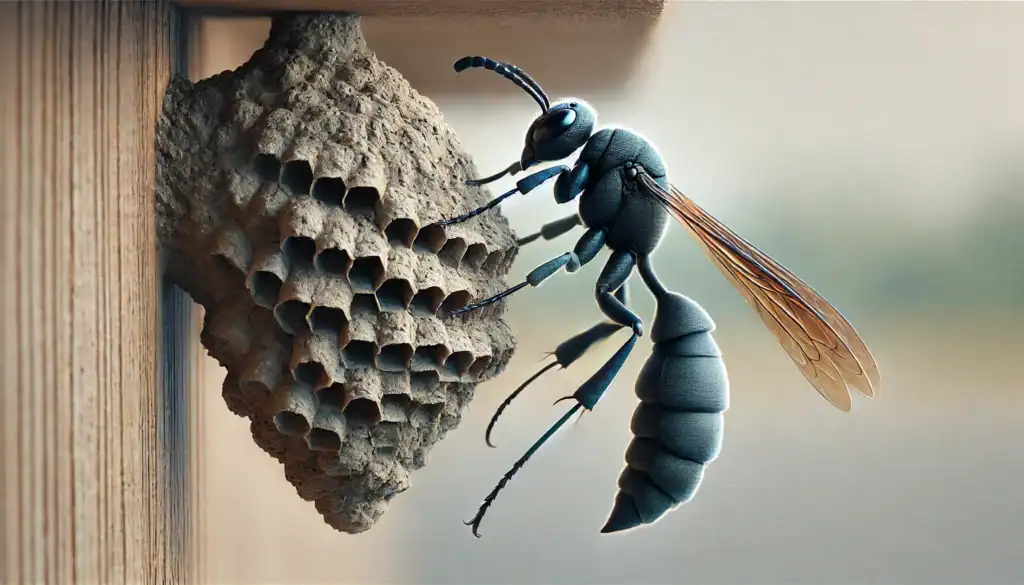
Coexisting Peacefully with Mud Dauber Wasps
There’s no need to seek to eliminate Mud Daubers, they are not going to hurt you. They are just little creatures trying to live our their short lives to the fullest. It’s completely possible to live alongside them peacefully. They are unlikely to approach humans and prefer quiet out-of-the-way spaces for nesting.
If you do happen to find a Mud Dauber nest, just leave it be if it’s not causing any harm – you really can live with a Mud Dauber nest in your garden. Mud Daubers do not grow to the larger lengths other wasps can and because of that their nests are usually a lot smaller too. They can be found under pergolas, back garden umbrellas or, sometimes, the underside of decking. These types of structures are fascinating to observe and can provide a glimpse into the life cycle of these industrious insects. However, if really necessary, nests can be relocated safely by professionals during inactive periods.
Again, as with the fear of other wasps, reactions are based on your own perceptions of the danger or stress and are not specifically related to the intentions of the wasp. In fact, the reaction of the wasp will be directly related to your own personal approach.
All that being said, the best option to live peacefully with Mud Dauber Wasps is to overcome your fear. This way you can achieve ambivalence around them and other wasps. There is no need to kill living creatures that do not want to do you harm. Try to motivate yourself to live in balance with the natural world by getting over your fear – you will also enjoy your life outdoors a lot more!
Enjoy the Outdoors Again, With the Help of Creature Courage
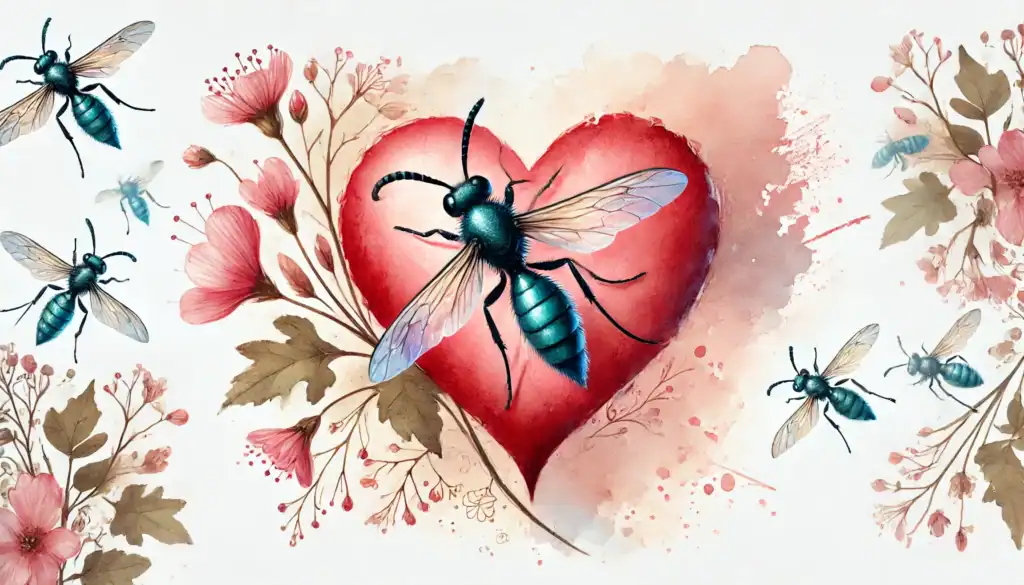
Why Compassion Matters
It’s worth reflecting on the value of compassion and understanding when it comes to overcoming phobias. Many fears stem from a lack of knowledge and an instinctive desire to protect ourselves. But learning about the role mud dauber wasps play in nature—and recognising their gentleness—can be profoundly healing.
By seeing these creatures not as threats but as fellow participants in the circle of life, we reduce fear through empathy. Compassion invites curiosity. Curiosity dissolves fear. When we shift our mindset from avoidance to awareness, our anxiety starts to fade.
This emotional shift is a crucial part of overcoming spheksophobia. Realising that mud daubers are not only harmless but helpful allows us to reframe our internal narrative. It opens a door to appreciation and peaceful coexistence.
How to Feel Calm Around Mud Dauber Wasps
If you feel scared around a mud dauber and start panicking, the first step to calming your body is to focus on your breathing. Try to take slow, deep breaths—in through your nose for a count of four, hold for four, and out through your mouth for four. This helps signal to your brain that you’re safe, which can ease the physical symptoms of panic like a racing heart or shaky hands.
Grounding techniques can also help—try naming five things you can see, four you can touch, three you can hear, two you can smell, and one you can taste. Another simple trick is to smile, even if you don’t feel like it. The act of smiling sends signals to your brain that can help lower stress and boost your mood, making you feel a little more in control.
It can also help to gently tense and then relax your muscles, starting from your feet and working upward. These small steps work together to help your body feel calmer and more settled.
Don’t try to run away or swat at the wasps, this would make a sting more likely to happen. The best thing you can do is just remain calm and still.
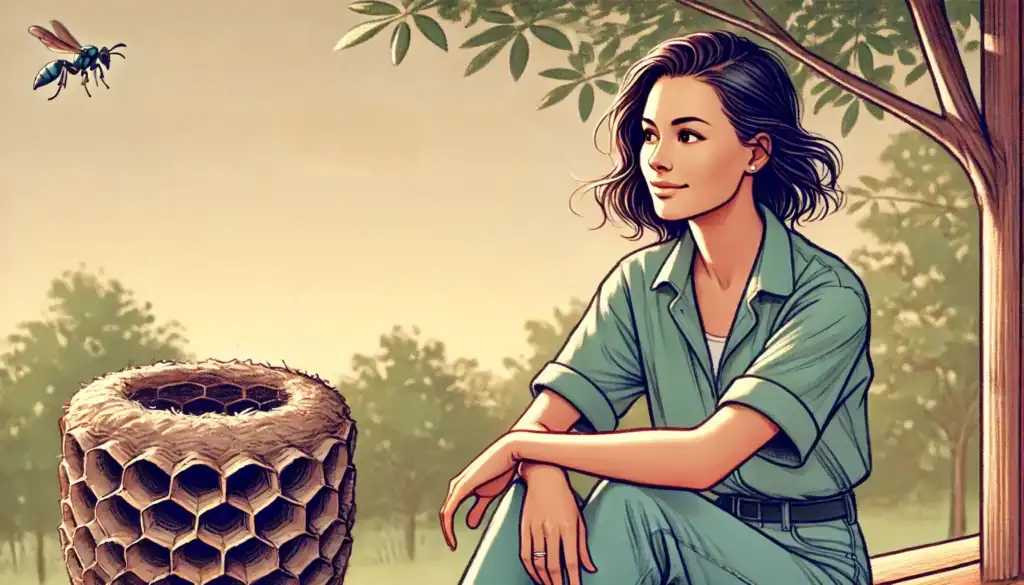
Effective Treatments for the Fear of Wasps
Spheksophobia is highly treatable, and recognising this is empowering. A variety of therapies are available to help individuals reclaim their lives. Cognitive Behavioural Therapy (CBT) helps people challenge and reframe irrational fears and thought patterns. Exposure therapy gently introduces individuals to the source of their fear in a controlled, safe environment, allowing desensitisation to occur gradually. Relaxation techniques such as deep breathing, visualisation, and progressive muscle relaxation reduce the physiological symptoms of anxiety.
In recent years, a greater emphasis has been placed on integrative therapies that combine these techniques with mindfulness, psychoeducation, and emotional regulation training. The key is to address both the conscious and unconscious mind, ensuring long-lasting change. Many people find success with traditional approaches, but these methods can be slow or incomplete if they don’t treat the root of the anxiety.
That’s where Creature Courage comes in. We provide a cutting-edge, holistic alternative that is not only effective but transformative. Our approach doesn’t just eliminate fear—it reshapes how you handle all forms of anxiety and emotional stress. We focus on equipping individuals with tools that support their mental health well beyond the initial phobia.
Why Creature Courage is the Best Solution
At Creature Courage, we specialise in helping people overcome animal phobias, especially insect phobias quickly and effectively. Most of our clients conquer their fear in just one day. Our holistic method blends multiple therapeutic techniques:
- CBT to reframe negative thoughts
- NLP (Neuro-Linguistic Programming) to rewire responses
- Gradual exposure in a safe, compassionate environment
- Mindfulness and emotional regulation tools
- Imagination exercises to gently reshape mental associations with the feared animal. By mentally rehearsing calm, positive interactions with mud dauber wasps in guided visualisations, individuals build new, empowering narratives. Over time, this inner reprogramming replaces fear-based reactions with calm and curiosity.
- Art therapy to express, process, and transform fear through creative exploration
This holistic approach not only removes the fear of mud dauber wasps but also empowers clients to handle other anxiety triggers with more ease and resilience.
Our results speak for themselves. Clients report not only relief from their phobia but improved overall mental wellbeing. With Creature Courage, you gain more than freedom from fear—you gain freedom to fully enjoy life. Get in touch today to get over the fear of wasps for good!
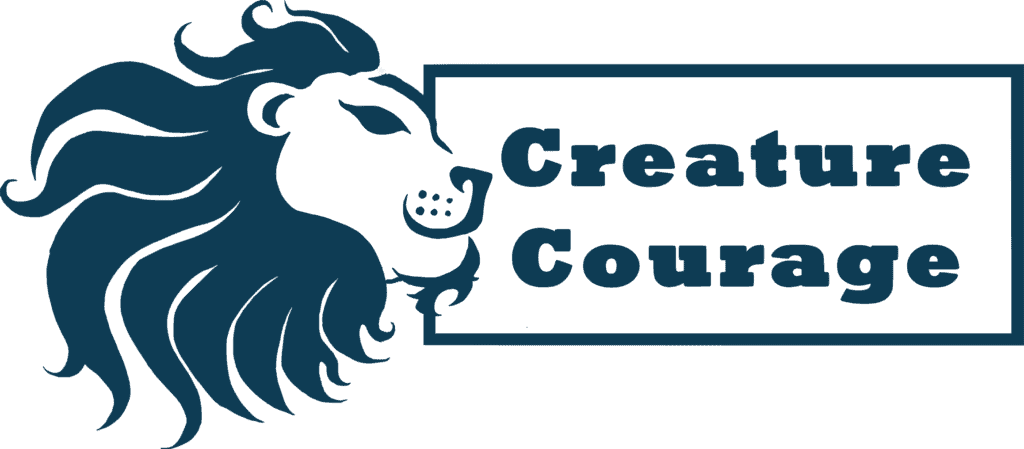
FAQ: A Quick Lowdown on the Fear of Mud Dauber Wasps
What is the fear of wasps called?
The fear of wasps is known as spheksophobia.
Are mud dauber wasps aggressive?
No, mud daubers are solitary and non-aggressive. They do not sting unless provoked and are far less dangerous than social wasps.
How common is a fear of wasps in the UK?
Around 5% of the UK population experiences wasp phobia, although many more have a general dislike or discomfort.
Can a mud dauber wasp sting me?
It is extremely rare. They only sting if directly threatened and their sting is mild unless you have an allergy.
Why should I get treated for my fear of mud dauber wasps?
Living with fear restricts your life. Treatment brings freedom, joy, and greater participation in everyday activities.
How does Creature Courage cure phobias?
We use a holistic blend of CBT, NLP, exposure therapy, and mindfulness. Most clients overcome their fear in a single session.
Is Creature Courage therapy only for wasp phobias?
No. Our method also helps with any general life-anxiety and, of course, we have therapies for overcoming other animal phobias – using our practices will make life easier overall.
How can I live safely around mud dauber wasps?
Mud daubers are beneficial to the environment and rarely interact with humans. Respectful coexistence is entirely possible.
